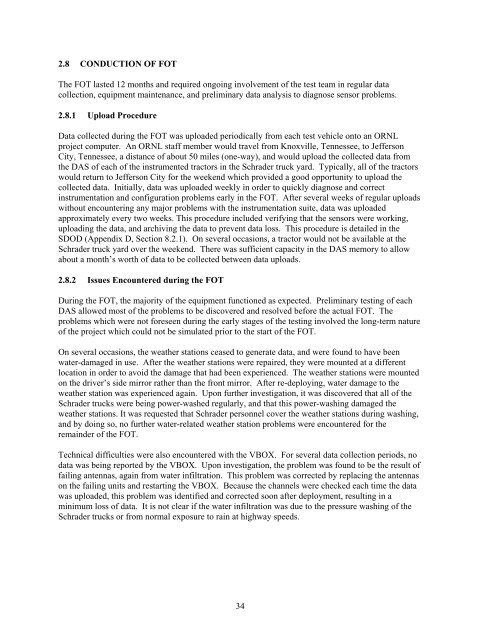Class-8 Heavy Truck Duty Cycle Project Final Report - Center for ...
Class-8 Heavy Truck Duty Cycle Project Final Report - Center for ...
Class-8 Heavy Truck Duty Cycle Project Final Report - Center for ...
Create successful ePaper yourself
Turn your PDF publications into a flip-book with our unique Google optimized e-Paper software.
2.8 CONDUCTION OF FOT<br />
The FOT lasted 12 months and required ongoing involvement of the test team in regular data<br />
collection, equipment maintenance, and preliminary data analysis to diagnose sensor problems.<br />
2.8.1 Upload Procedure<br />
Data collected during the FOT was uploaded periodically from each test vehicle onto an ORNL<br />
project computer. An ORNL staff member would travel from Knoxville, Tennessee, to Jefferson<br />
City, Tennessee, a distance of about 50 miles (one-way), and would upload the collected data from<br />
the DAS of each of the instrumented tractors in the Schrader truck yard. Typically, all of the tractors<br />
would return to Jefferson City <strong>for</strong> the weekend which provided a good opportunity to upload the<br />
collected data. Initially, data was uploaded weekly in order to quickly diagnose and correct<br />
instrumentation and configuration problems early in the FOT. After several weeks of regular uploads<br />
without encountering any major problems with the instrumentation suite, data was uploaded<br />
approximately every two weeks. This procedure included verifying that the sensors were working,<br />
uploading the data, and archiving the data to prevent data loss. This procedure is detailed in the<br />
SDOD (Appendix D, Section 8.2.1). On several occasions, a tractor would not be available at the<br />
Schrader truck yard over the weekend. There was sufficient capacity in the DAS memory to allow<br />
about a month’s worth of data to be collected between data uploads.<br />
2.8.2 Issues Encountered during the FOT<br />
During the FOT, the majority of the equipment functioned as expected. Preliminary testing of each<br />
DAS allowed most of the problems to be discovered and resolved be<strong>for</strong>e the actual FOT. The<br />
problems which were not <strong>for</strong>eseen during the early stages of the testing involved the long-term nature<br />
of the project which could not be simulated prior to the start of the FOT.<br />
On several occasions, the weather stations ceased to generate data, and were found to have been<br />
water-damaged in use. After the weather stations were repaired, they were mounted at a different<br />
location in order to avoid the damage that had been experienced. The weather stations were mounted<br />
on the driver’s side mirror rather than the front mirror. After re-deploying, water damage to the<br />
weather station was experienced again. Upon further investigation, it was discovered that all of the<br />
Schrader trucks were being power-washed regularly, and that this power-washing damaged the<br />
weather stations. It was requested that Schrader personnel cover the weather stations during washing,<br />
and by doing so, no further water-related weather station problems were encountered <strong>for</strong> the<br />
remainder of the FOT.<br />
Technical difficulties were also encountered with the VBOX. For several data collection periods, no<br />
data was being reported by the VBOX. Upon investigation, the problem was found to be the result of<br />
failing antennas, again from water infiltration. This problem was corrected by replacing the antennas<br />
on the failing units and restarting the VBOX. Because the channels were checked each time the data<br />
was uploaded, this problem was identified and corrected soon after deployment, resulting in a<br />
minimum loss of data. It is not clear if the water infiltration was due to the pressure washing of the<br />
Schrader trucks or from normal exposure to rain at highway speeds.<br />
34
















